Nature's Best :: Don Smith Photography
Exploring our incredible world one image at a time!
My 12 Favorite Images Of 2013!
Posted on December 31, 2013

Image #1 – Lightning Strike on Mt. Woolsey, Point Imperial, North Rim, Grand Canyon National Park, Arizona
Canon 5DMKIII, 35mm, f/22, 1/10 sec., ISO 50, The Lightning Trigger
HAPPY NEW YEAR EVERYONE!
We have finally arrived at what I feel was my number one image of 2013. Gary Hart and I had just concluded the first of two Monsoon Workshops that we were teaching at Grand Canyon National Park. We had the weekend open before the second workshop was to begin along the south rim on Monday.
Later that Friday morning, we noticed that dark clouds were starting to gather and thicken. Of course we had to grab our gear and head towards “the darkest part of the storm.” We decided to head towards Point Imperial at an elevation of 8,803 feet, the point overlooks the Painted Desert and the eastern end of Grand Canyon.
As we pulled into the parking area, we could see lightning strikes out to our left. We quickly grabbed our gear and got to work.
In order to capture daytime lightning, one needs some help. My assistance comes from a product called The Lightning Trigger, a unit that attaches to the camera’s hot shoe that senses the down bolt and times the camera’s shutter to fire on the return bolt (the lightning flash that we actually see).
The cell that we were watching began to drift out towards Mt. Woolsey. Another cell had fired up beyond the point and both seemed to be heading on a collision course towards one another.
It should be noted that lightning photography is never safe. Lightning can jump up to 25 miles. We were no more than 3 miles from where this lighting was firing – yeah, I know, pretty stupid on our end.
As the two cells seemingly merged, this incredible sheet of rain dropped from the ominous clouds. It was epic – almost biblical! I had my camera oriented in the vertical position shooting this amazing band of rain, then decided to change lenses and compose a wide horizontal scene that you see here. As if on queue, this magnificent cloud-to-ground lighting bold crashed out the clouds and I heard my camera firing.
Of course my adrenaline kicked into high gear at the anticipation that I may have captured something very special. Within a minute, that anticipation turned to sheer terror as I realized that the cell had drifted directly over the top of where Gary, myself, and one of our workshop participants were shooting.
A blinding bolt of lightning seemingly struck right over our heads followed immediately by a ear-shattering crash of thunder. Everyone instantly bolted to the cars parked about 100 yards away. I was 4 weeks removed from knee replacement surgery but moved as fast as I could (hopping like a deranged bunny), while all the while saying a prayer that I would make it safely to the confines of the car. Fortunately a higher power was looking over us and we all reached the car safely.
As the storm crashed around us, I quickly started reviewing my images on my camera’s LCD. When I saw this frame, I couldn’t believe it! It had it all, the ominous storm clouds, the incredible band of rain (which one observer claimed was God’s beard), and a bolt of lightning smack in the middle of the band! Clearly my number one photograph of 2013!
We will be offering another Monsoon Photo Workshop this August if your would like to join us. For more information, please click here: 2014 Gary Hart and Don Smith Grand Canyon Monsoon Photo Workshop.

Image #2, Hoar Frost and Mist, Sentinel Meadow, Yosemite National Park
Canon 5DMKIII, 125mm, f/22, 2.5 sec., 100 ISO, Singh-Ray LB Polarizer
My 2nd favorite images of 2013 came on a frosty fall morning as mist hovered over the floor of Sentinel Meadow in Yosemite Valley.
What I really liked most about this image is the layers. Also, this is a scene that I really had to find – it wasn’t obvious at first though all the elements were there.
I knew that I wanted to somehow combine this colorful foreground with the layer of mist and what was left of the fall color on the trees in the background. Three distinct layers, but all working in harmony to create this snippet of nature.
What I also wanted to convey with this image was the frosty cold morning I was experiencing. The frost clinging to the foreground foliage, combined with the layer of mist hovering off the Valley floor, hopefully relays that experience.
Finding isolated compositions like this in nature are often more rewarding to me personally than the grand view images. These images become a bit more special rather than capturing something that is obvious.

Image #3 – Kilauea Caldera Under Milky Way, Volcanoes National Park, Hawaii
Canon 5DMKIII, 16mm, f/2.8, 30 seconds, 1600 ISO
My third favorite image of 2013 comes from the Big Island of Hawaii and Volcanoes National Park. This image was captured while I was helping co-teach Gary Hart’s Big Island Volcanoes and Waterfalls workshop this past September.
We had taken the group to Volcanoes and shot a sunset near the caldera. We then went to dinner and kept our fingers and toes crossed that we would be greeted by clear skies after dark (no promises when photographing anywhere in the tropics).
But as luck would have it, when we emerged from the restaurant, not a cloud was in the sky. We drove back to a location near the caldera where it aligned with the vibrant Milky Way and began our shoot.
Exposures require a high ISO on moonless nights, and this image needed an ISO 0f 1600. Processing this image in Lightroom 5 never met with my satisfaction as the image proved too noisy and I feared my photo agency, Getty Images, would reject it.
Then I discovered DxO Optics Pro 9 RAW processing software. I reprocessed the image using their PRIME noise reduction mode and it nailed the image for me. I got the contrast I needed to bring out the Milky Way without excess noise!
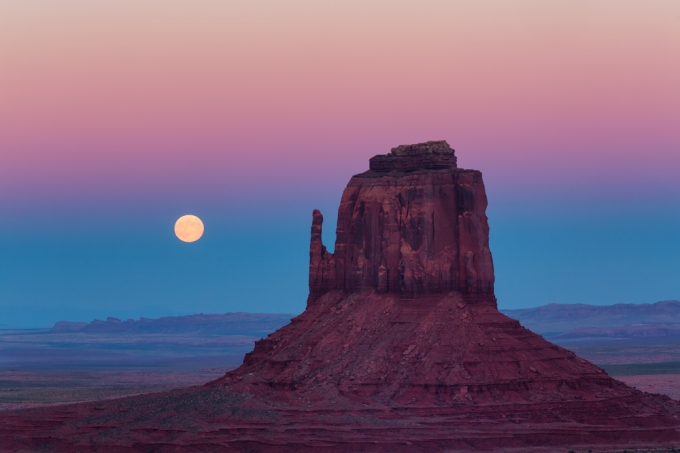
Image #4 – Full Moonrise and East Mitten, Monument Valley, Arizona
Canon 5DMKIII, 170mm, f/16, 0.6 sec., 200 ISO
The old saying, “When life hands you lemons make lemonade,” was never more true for the reason this image came to be.
Thanks to our political genius’s in Washington, our National Parks were closed (way to go ladies and gents)! I was about a week away from the start of my Arches/Canyonlands workshop.
With both parks closed, I contacted my friend and co-instructor for this workshop, Gary Hart, and said, “we either cancel this workshop or get into scramble mode to come up with alternate locations.” Gary fortunately talked me into the latter.
After multiple phone calls to other state parks in the area, and talking to some locals, we decided we could find enough quality locations that we could make it work (much to the relief of our participants).
Gary called me and said that he had been looking at potential moonrise locations (as I had booked this workshop to coincide with the full moon), and said it appeared as if a full moon would be rising between the east and west mittens at Monument Valley.
I immediately jumped onto The Photographer’s Ephemeris and sure enough, there was the line of the moon’s rise path, at sunset, just right of center between to two famed mittens.
At the Orientation Meeting for the workshop, we ran this idea past the workshop participants and all were game for the 2 1/2 hour drive (each way) from Moab to Monument Valley.
We caravaned down to Monument Valley and toured the loop road, then went back to the rim (near the The View Hotel) and setup for this shot. As if on queue, the sun set, a vivid twilight wedge appeared in the eastern horizon, and in all its glory, this beautiful full moon began to rise! It was almost mystical.
Most of my workshop participants were so thrilled with seeing and photographing this scene, that it became apparent that I would have to keep it in the rotation for next year’s workshop – that I now call – Arches/Canyonlands National Parks and Full Moonrise at Monument Valley Photo Workshop.

Image #5 – Early Morning Fury, North Rim, Grand Canyon National Park, Arizona
Canon 5DMKIII, 75mm, f/16, 1/4 sec., ISO 100, Singh-Ray LB Polarizer
Image #5 of my 12 favorites of 2013 comes from the north rim of Grand Canyon National Park this past August. Gary Hart and I were co-teaching back-t0-back workshops in our first annual Grand Canyon Monsoon Photo Workshop.
On the final morning of our second workshop, we met the group in the lobby of the Grand Canyon Lodge for a planned sunrise shoot at Bright Angel Point. As we were gathering, I noticed flashes of lightning across the canyon rim.
In the dark, we all used headlamps and hustled out to the point (more of a hobble for me as I was still recovering from knee surgery). One never knows about lightning. We do know that cells move frequently over the canyon, but this one seemed to be stalled across from us over the south rim.
As the sun started to rise, it skimmed warm light across the canyon walls and formations. We all had Lightning Triggers on our cameras (the only practical way of capturing daytime lightning).
We were like giddy school kids at recess as our cameras were clicking with each bolt we saw. Occasionally, we would check the LCD to see what we were capturing. As the sun started to crest the eastern horizon, and much to our delight, this vivid rainbow appeared (at least the base of it).
Suddenly, the bolts intensified and much to my delight, I had captured this image! I know that most of 0ur participants had captured similar images. In total, we shot for nearly 2 hours and then decided it would be tough to out-do what we had.
Breakfast tasted really good that morning – funny how that happens when you know you’ve got something special in the can!
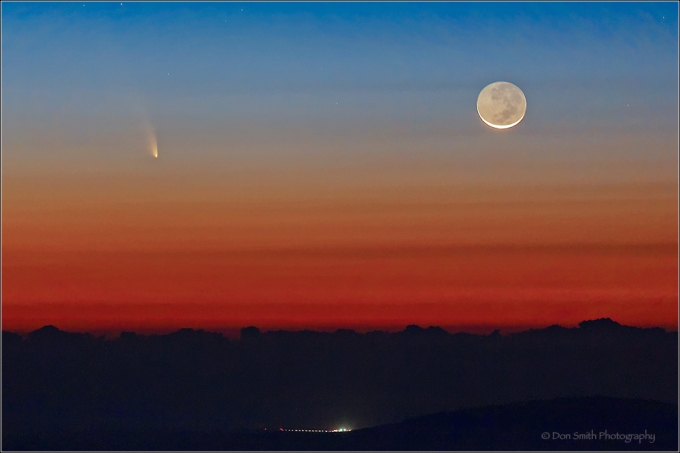
Image #6 – Comet Pan-STARRS, Haleakala National Park, Maui
Canon 5DMKIII, 200mm, f2.8, 4.0 sec., 800 ISO
And now for my top six images of 2013. Image number 6 comes from just below the summit of Maui’s Haleakala National Park this past March.
I was co-teaching Gary Hart’s Maui Workshop when we took the group to the summit of Haleakala National Park for a sunset shoot. One literally goes from 80 degrees and tropical (at ocean-side), to winter-like conditions atop the summit.
The temperature drops 3º for every 1000 feet of elevation, so at the Haleakala Visitor Center’s 9,740-foot elevation (where most people watch/photograph the sunrise/sunset) it’s about 30º colder than at sea level.
On this particular evening, we had to add about a 30-mile-per-hour wind, and the wind-chill made it fell about in the mid-20’s – quite a shock to the old system!
It just so happened that on the evening we were on the summit, it coincided with comet Pan-STARRS being the closest to the setting moon. The moon was at its crescent stage. Note: Comet Pan-STARRS was discovered in June 2011 by a team of astronomers using the Panoramic Survey Telescope and Rapid Response System (or PAN-STARRS), a telescope in Hawaii.
Unfortunately, sunset was mixed with clouds and the sky was obscured. We waited in the parking lot and ate a sandwich but it became rapidly apparent that the workshop participants were ready to call it a day. Gary and I weren’t (we can be stubborn old farts when we think a great picture can materialize)!
Two carloads already had left and the three remaining participants were with us. They had packed also so we decided to drive out of the main parking area atop the summit. About two miles down the road, we got below the clouds and this scene unfolded before our eyes.
The comet was not apparent to the naked eye, but with the aide of a telephoto lens, there it was – sitting just above a beautiful twilight wedge. The temperatures were still very chilly and we told the others in the car to get their gear out – only one did (to our surprise).
I have various crops of this image, but I liked the lights of this small town below to give a sense of scale to the moon and comet.
NOTE: The moon is not full in this image though it appears to be – look closely and you can see the outline on the crescent!

Image #7 – Moonset Over Horseshoe Bend, Page, Arizona
Canon 5DMKIII, Nikon 14-24mm, f/22, 3.2 second timed-exposure, ISO 200, Fotodiox circular polarizer
MERRY CHRISTMAS EVERYONE!
Iconic locations are such a challenge for me to photograph. I don’t want to simply show up and replicate what has been done by millions before me.
During my Northern Arizona Workshop, I take my participants to Horseshoe Bend (in the dark) to capture first light at this beautiful southwest setting where the Colorado River literally forms a horseshoe around cut Navajo sandstone.
I purposely time this morning shoot to include a setting moon. Prior to the sun rising, morning hues enliven the horizon as the moon makes it rapid descent leaving a small window of opportunity to capture this scene under even lighting conditions.
This past year, I crawled (literally) out to the edge with my Nikon 14-24 set at 14mm, and captured this image. The power of adding a moon to my images never ceases to amaze me. In this image, it helps to draw the eye through the scene, making it my 7th favorite of the year!

Image #8 – Dawn at Hanalei Bay, Kauai, Hawaii
Canon 5DMKIII, 24mm, f/16, 6 minute timed-exposure, 100 ISO, Singh-Ray 5 stop Mor-Slo
My 8th favorite image of 2013 comes from my annual Kauai Workshop that I hold each June. On this particular morning, we awoke in the dark and made the 45-minute drive to Hanalei Bay.
During the day and evening, this idyllic bay is engulfed with beach-goers, sailboarders, paddle-boarders, etc., but at dawn, the beach/bay is nearly deserted. Hanalei Bay has served as the backdrop for many a Hollywood movie, including George Clooney’s The Descendants.
My workshop group arrived just as dawn color was starting to come to life. We parked on the beach and were within 60 feet from this scene.
I decided to setup my camera about a foot off the ground. I added a Singh-Ray 5 stop Mor-Slo neutral density filter and set the camera into bulb mode.
One of the cool elements about digital exposures is that they are linear. I calculated an exposure for 10 seconds, then working a bit of math in my still sleepy mind, I calculated this exposure for 6 minutes.
With the movement of the water and the clouds, the image became a symphony of color and movement – peaceful – just the feeling I had at that time of the morning in this perfect island setting!
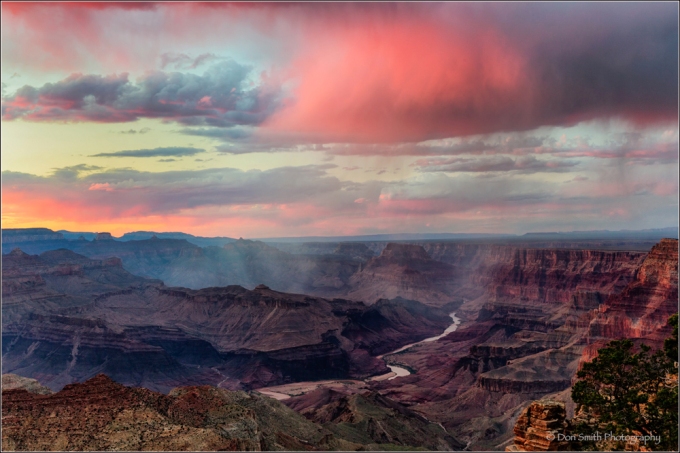
Image #9 – Evening Showers, Desert View, Grand Canyon National Park, Arizona
Canon 5DMKIII, 35mm, f/16, 2.0 sec., 100 ISO, Singh-Ray Slim LB Polarizer, Singh-Ray 2-stop graduated neutral density filter
My 9th favorite image of 2013 was captured during Gary Hart and my inaugural Grand Canyon Monsoon Season Workshop this past August. This was one of my first outings since my knee replacement surgery 3 1/2 weeks prior.
We started the workshop on the north rim, then caravaned the group down to the south rim for two days of shooting. Desert View is one of my favorite locations in the entire park because of the view it affords of the Colorado River below.
On this particular evening, rain squalls were moving up the canyon from west to east as the sun was setting. Just as the sun hit the horizon, it threw light up and under these storm clouds to color up the sky.
Some lingering bands of rain showers caught enough light to highlight the falling rain completing the image.

Image #10 – Dawn, Grand Teton National Park, Wyoming
Canon 5DMKIII, 50mm, f/16, 1.3 sec., ISO 100, Singh-Ray Slim LB Polarizer
My 10th favorite image of the year came about quite by accident. On this particular morning, my Grand Teton workshop group departed Jackson for Oxbow Bend. My co-instructors, Scott Schilling, Pierre Steenberg and I were in the last car following the group.
As we approached the Moran gate, a young ranger put up his hand for us to stop. I saw he had four large orange cones near his booth. As I rolled down the window, he said the park was officially closed due to the government’s inability to reach a budget settlement hours earlier.
I proceeded to plead with him that we were workshop instructors with a valid Commercial Use Authorization permit and that our group was just up the road awaiting sunrise. He apologized, but said we would have to turn around.
Scott made a quick phone call to one of our group members alerting them what had happened and we headed back towards Jackson and stopped to photograph this scene near Triangle X Ranch. I made this image about 10 minutes before actual sunrise and loved the juxtaposition of the morning hues against the fall color of the cottonwoods in the distance.
Our group had great light at Oxbow Bend, and we completed the workshop at awesome locations outside of the park (some that will remain in the lineup for next year’s workshops)!
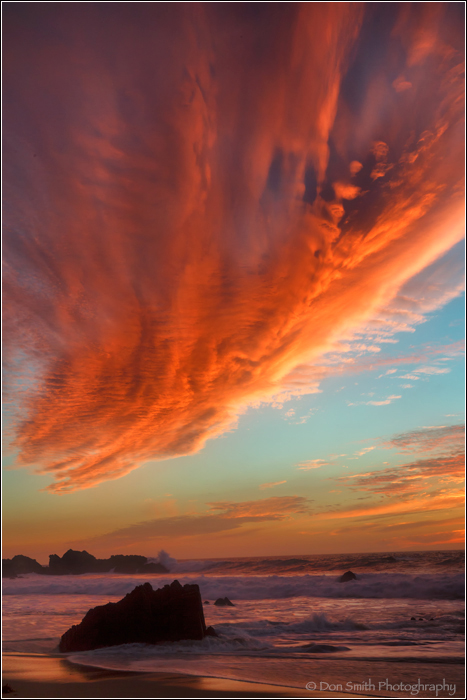
Image # 11 – Winter Sunset at Garrapata State Beach
Canon 5DMKIII, 44mm, f/16, 1/10th sec., ISO 200, Singh-Ray Slim Polarizer
My 11th favorite image of the year was captured in early February while teaching a private lesson and shooting a sunset at Big Sur’s Garrapata State Beach. The sun had actually set and the color on the horizon had momentarily disappeared. I cautioned my client to not be so quick to pack as we had an extremely clear horizon that evening.
As the sun sank lower below the horizon, it cast warm rays up and under this stratus cloud that was hanging along the shoreline. We quickly moved in front of this rock to anchor the foreground and the light on the cloud became incredibly rich and saturated.
Generally speaking, one does not often see this type of saturated light after sunset on the coast. This light is more often seen in the mountains; yet, on this evening, we got one heck of a show!
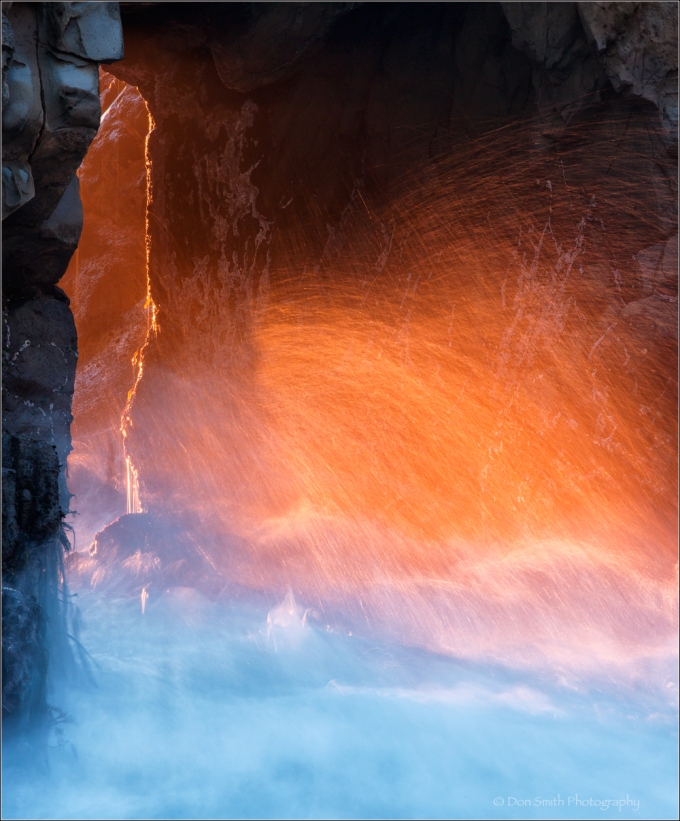
Image #12 – Devil’s Cauldron, Pfeiffer Arch
Canon 5DMKIII, 200mm, f/22, 2.0 sec., 200 ISO, Singh-Ray CC Polarizer
Today I start with Image #12, that I captured last week at Pfeiffer Arch along the Big Sur coast. This image is both exciting and sad, as a day after I captured this scene, the Big Sur Pfeiffer Ridge fire broke out along the mountain ridge across from this arch. As I write this, firefighters expect full containment (today), but 34 homes were destroyed.
During December and January, on a clear-sky day, the setting sun aligns with the opening of the arch and allows for this incredible warm light to spill through the opening. One must time the wave surging through the arch. As the mist from the funneled water rises, it is backlit by the sun.
I personally try for a different approach each time I’m at the arch. On this particular evening, the color was gorgeous and I decided to try a tight shot with a 200mm. This was my second to last frame before the sun finally set allowing for the intense warm color.
Sadly, for all those who lost their homes in the Pfeiffer fire, our thoughts and prayers go out to you.
2014 Photo Workshops – Complete List
5th Annual Kauai Workshop – Garden Isle and Tropical Paradise – June 20-24, 2014 (3 spots remaining)
Software Discounts
Photomatix Pro 4.2 type in code at checkout: donsmithphotography 15% discount
Topaz Software type in code at checkout: SMITHPHOTO 10% discount
Helicon Focus click on link to receive 15% discount
Hardware Discounts
Special Year End “Black Friday” Offer From Think Tank Photo NOTE: (Use Promo Code WS-643)
Category: Landscape Photography Tagged: grand-canyon, Imperial Point, lighting, monsson, north rim, storm
Utilizing Lines and Shapes to Lead the Eye – Creating Flow
Posted on June 4, 2011
Simplifying a scene in nature is sometimes harder than you would think – though I know most of you have experienced this. One of the tricks I use when my scene seems too cluttered is to try and visualize every element before me as either a line or geometrical shape. I try to find a common thread between elements; a connection of some sort that will lead the eye through the scene. I call this flow. Does my composition allow for my viewer’s eye to flow through the frame?
Today’s image is a good case in point. I found this scene behind my hotel just north of the casino lights at South Lake Tahoe. Our workshop group had been snowed-out of our sunset shoot (the first of three storms in four days to hit the area). By 7 pm we threw in the towel and headed our separate ways for dinner. Once finished, I came back to the hotel room, looked out my back window and noticed that the relentless snow had momentarily stopped – a quick glance at my watch revealed that we were right on posted sunset time. I told my friends Mike Hall and Scott Schilling that I was going to wander out and see how it looked as the property backed right onto a public beach. In a matter of minutes we were treated to this scene of the pier with one caveat – someone had put their footprints through the fresh snow.
While bemoaning our bad luck, I started to notice the light brightening allowing for the clouds in the background to look extremely dark. This nice glow appeared on the Lake’s surface and I quickly dropped to my knees and photographed this frame. Besides the light, what really drew me was the simplicity of the lines created by the edges of the pier that led my eye up and through the frame – flow! I decided to relegate the dark clouds to just the top 1/6th of my frame and liked how the horizon line served as a stopping point for the eye so as not to allow it to leave my frame.
We as photographers have an incredible opportunity to limit where our viewer’s eye will go by proper framing. Thanks to an illusion called the Ponzo affect, the pier (like a set of railroad tracks) appears to get smaller as it trails off in the distance. This is something our eye/brain is used to seeing even though intellectually we understand that the end of the pier is the same relative size as the foreground. My low perspective also exaggerates this phenomenon. So, did I arrive at this composition with my first try? No. In fact, I started more wide angle and then kept refining (tightening) the composition in subsequent frames. In essence, I was trimming anything that did not belong or add to the scene – simplifying – creating flow.
So what happened to those footprints I spoke of earlier? Well, in the final analysis they were more of a distraction than an aid so I cloned them out with the help of the patch tool. In essence, they disrupted the flow so they had to go! Did I alter reality? For this moment yes, but had I arrived 10 minutes earlier, perhaps they would not have been there. This is fine art not journalism. I simply restored the pristine look to the scene that I intuitively knew existed. Had I moved or cut-off a section of the pier, then I would have over-stepped my boundaries. It’s really one of those issues that every serious landscape photographer will have to deal with sooner or later. My position is I won’t move elements, but I will remove something that at one point was never there (trash, twigs, or in this case – footprints). Yeah, I know you could make the argument that at one point this pier never existed, but hopefully you get my point.
The bottom line is that by using the lines and shape of the pier, I created flow for my viewer’s eye. Think about this the next time your scene looks a bit chaotic. Tighten, move, change your perspective and play with the shapes and lines in front of you. See if you can create some flow in your images.
Category: Landscape Photography Tagged: composition, flow, form, fresh snow, leading the eye, lines, photography, shapes, south lake tahoe, storm, winter
Recent Posts
- Why I Will Never Fly American Airlines Again :: At Least Not After Next Tuesday…
- New Blog Site For Don Smith Photography!
- Do You Look Or Do You See? Developing Your Creative Vision :: Part 2 of 3
- Do You Look Or Do You See? Start With 10,000 Hours Of Practice :: Part 1 of 3
- Photographing Wildflowers In The Wind At Big Sur’s Garrapata State Park
